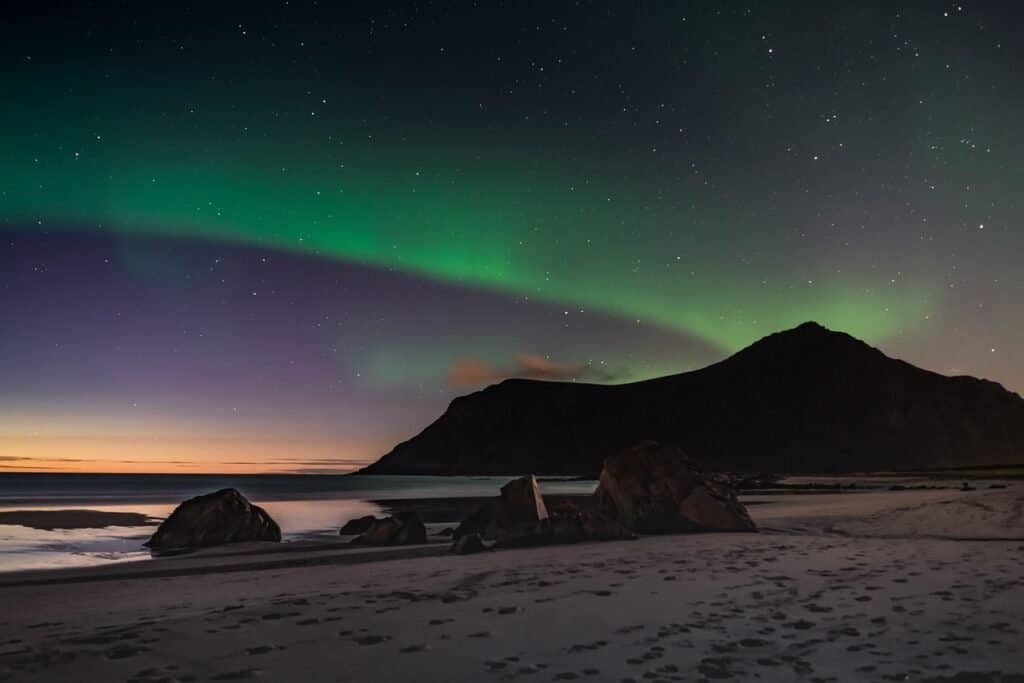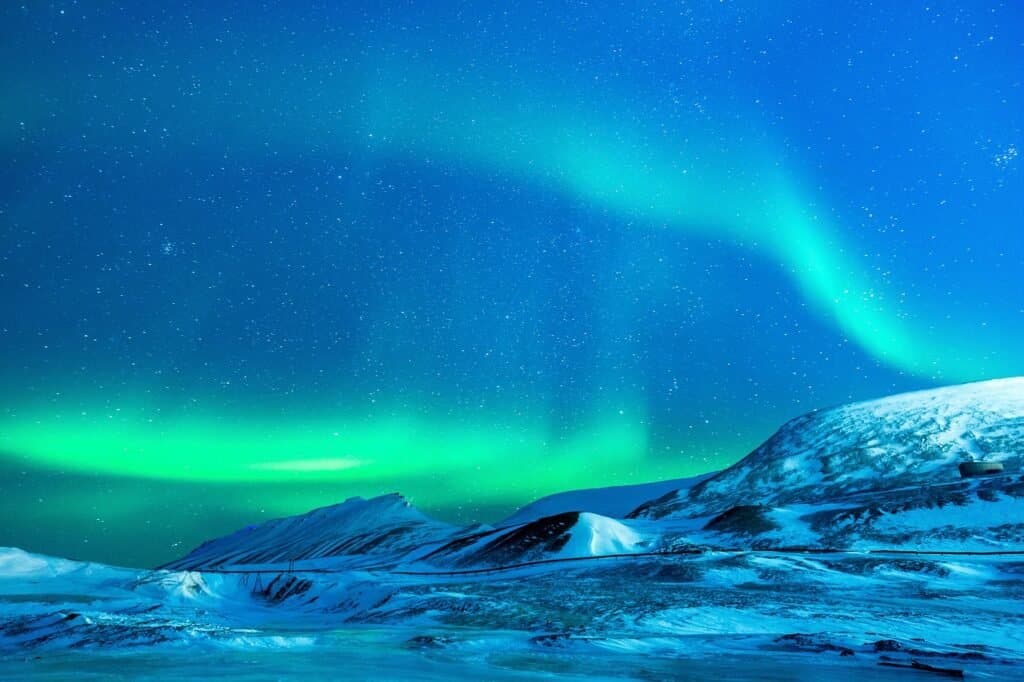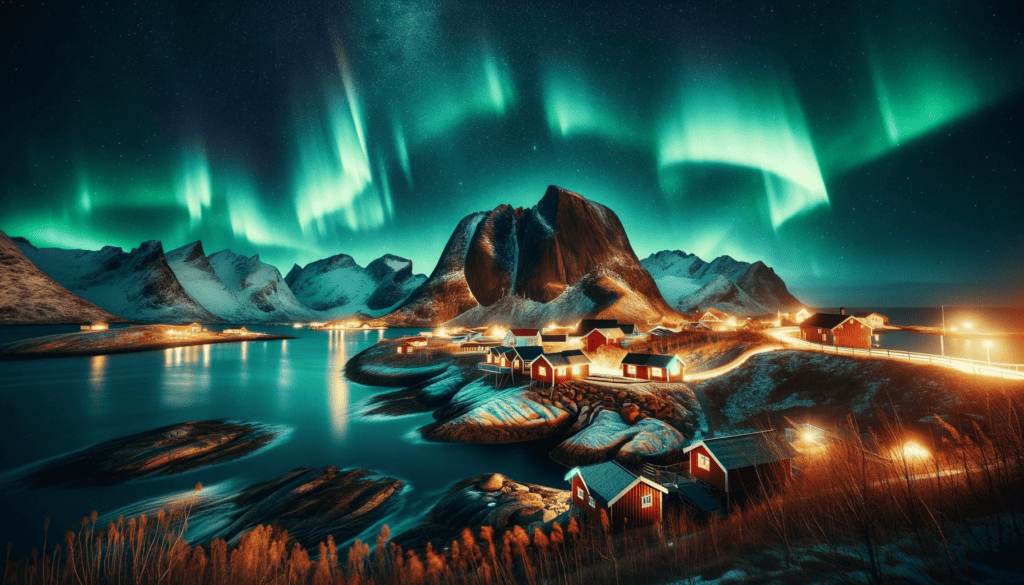
When people find out I live in Trondheim, Norway one of the first things they ask – apart from why and is it dark all year round etc. – is whether I get to see the Northern Lights. I have indeed seen the amazing Aurora from my home, but it’s rarer than up north. This reply usually elicits questions about how and where they can go to have the best chance of seeing the lights themselves.
This is why I wrote this article – it gives you all they – and you – need to know.
Reveal nature’s dazzling light show by embarking on an adventure to witness the mystical Northern Lights across Norway’s striking landscapes. I cover the prime viewing locations, ideal seasons, photography tips, and everything you need to know to experience the magic of the aurora borealis.
Experience nature’s ethereal masterpiece in Norway as colourful curtains of light dance through the night skies. Witnessing the awe-inspiring aurora borealis, commonly known as the northern lights, is a once-in-a-lifetime opportunity.
This celestial phenomenon results from solar particles interacting with gases in the atmosphere, creating a magical array of green, pink, purple, blue, and yellow hues illuminating the dark.
Norway’s optimal location directly under the Auroral Oval and naturally stunning landscapes create prime conditions for seeing the northern lights.
Top Northern Lights Viewing Destinations in Norway
The Spectacular Lofoten Islands
With dramatic jagged peaks, deep fjords, and charming fishing villages dotting the coastline, the Lofoten Islands paint a striking scene made even more magical when the northern lights ignite the sky. The minimal light pollution and wide-open vistas create ideal aurora viewing conditions here. Base yourself in a traditional fisherman’s cabin, known as a “rorbu”, in villages like Reine or Å for unmatched access to nature.
Vibrant Tromsø
Experience the best of both worlds in Tromsø, an energetic port city situated amidst gorgeous Arctic wilderness. Its location directly under the Auroral Oval inside the Arctic Circle ensures frequent opportunities to witness dazzling displays of the northern lights. Tromsø also offers vibrant nightlife, a thriving culinary scene focused on local seafood, fascinating museums, historic landmarks, and easy access to nature.
Historic Alta
The northern Norwegian city of Alta carries great scientific significance in aurora borealis research as home to the world’s first northern lights observatory built in the late 19th century. In addition to amazing light shows dancing across the skies, learn about the myths and science surrounding this phenomenon at Alta’s fascinating Northern Lights Center located right under the Auroral Oval.
Remote Finnmark County
Journey to Finnmark, Norway’s northernmost county sharing a border with Russia, for untouched wilderness ideal for witnessing the northern lights. With a sparse population spread across its expansive terrain, minimal light pollution, roaming reindeer and strong ties to indigenous Sami culture, Finnmark provides remote locales perfect for chasing the aurora. Base yourself in communities like Alta, Hammerfest or Lakselv.
The Magical Svalbard Archipelago
Situated halfway between mainland Norway and the North Pole, the remote Svalbard Islands offer extraordinary opportunities for viewing the northern lights. Long polar nights mean more chances to see the aurora swirling overhead with little ambient light to dilute the experience. Outdoor hot springs add an extra level of magic.
Historic Northern Towns
In addition to natural wonders, Norway offers opportunities to observe the dazzling northern lights from historic small towns that provide their charm. Locales like Mo i Rana, Narvik, Bodø, and Harstad lie directly under the Auroral Oval and feature minimal light pollution and wonderful cultural attractions.
Mainland Parks & Reserves
Along Norway’s mainland, national parks and nature reserves offer excellent dark sky options for witnessing the aurora. Jotunheimen National Park, the Saltfjellet-Svartisen National Park near the Arctic Circle, and Varangerhalvøya National Park along the Russian border provide stunning settings.
Prime Northern Lights Viewing Seasons
- October-March: The long, dark winter nights provide the best opportunities to see magnificent light shows, especially clear nights when solar activity is high. This prime viewing season sees locations nearest the Arctic Circle and further north immersed in 24 hours of darkness.
- September & April: During the shoulder seasons of fall and spring, you can catch uniquely stunning views of northern lights with the “blue hour” twilight colours mixing with the aurora. With more daylight than winter, but still longer nights, these months offer milder temperatures but still ideal dark evening skies.
- Summer: While the midnight sun illuminates the summer months, it is still possible to catch glimpses of the northern lights in northern Norway between June and August very late at night into the early morning hours when skies darken slightly. This offers a different perspective on the lights.
What Influences Northern Lights Activity

Solar Activity & Geomagnetic Storms
The frequency and intensity of aurora borealis displays are heavily dependent on space weather and solar wind activity. When the sun ejects charged particles during increased activity like solar flares and coronal mass ejections, these can interact with Earth’s atmosphere to create vibrant light shows if they collide at just the right angle.
Monitoring space weather forecasts tracking solar wind levels and geomagnetic storm activity can help predict when the northern lights may be most visible. Apps like Aurora Forecast provide real-time alerts when space weather conditions indicate potential for northern lights visibility.
Time of Day
Since the aurora is only visible in dark skies, the time of day with the highest probability of sightings is between 9-10 pm to 2 am when it is fully dark across the night sky in northern Norway. However, during shoulder seasons or summer, viewing may be better slightly earlier in the night or in the very early pre-dawn hours when darkness returns.
Cloud Cover & Precipitation
Clear skies are crucial for successful northern lights viewing since heavy cloud cover or storms will obstruct visibility. Cloud cover forecasts are helpful in predicting viewing conditions. However, the weather in Norway is notoriously fickle, especially in the north, so some luck is involved!
Altitude & Location
To best view the full arc and shapes of the northern lights dancing overhead, it is ideal to be located directly underneath the Auroral Oval in the northern regions of Norway. Darkness, lack of light pollution, and open views of the northern horizon also maximize the visibility of the lights. Higher altitudes provide a wider perspective of the sky.

Tips for Successfully Viewing the Northern Lights
- Check extended weather forecasts and solar/geomagnetic activity to time your trip when ideal conditions align. But remain flexible!
- Research locations with minimal light pollution, wide open vistas, and easy northern horizon access when choosing lodging or sightseeing spots.
- Use resources like cloud cover and aurora forecasts to plan daily activities and target locations with the highest chance of clear skies.
- Bring proper camera equipment suited for long-exposure night photography. A sturdy tripod is essential along with extra batteries and large memory cards.
- Dress very warmly in the wind and waterproof thermal layers and outerwear to comfortably withstand frigid Arctic temperatures through the long nighttime hours.
- Book accommodations and any tours with expert guides well in advance for prime northern lights season to secure availability when demand is very high.
- If possible, allow several days of flexibility in your itinerary to have the best chances of catching the lights during your stay as the weather allows.
- Seek out locals’ guidance, like hotel staff and tour guides, for real-time intel on ideal viewing spots and activities. Their insider knowledge is invaluable!
- Remain patient and persistent! The northern lights are notoriously fickle and unpredictable. Multiple attempts will greatly improve the odds of success.
- Avoid light pollution when possible by venturing away from large towns and seeking darkness to optimize visibility.
Planning Your Northern Lights Adventure
Choosing Locations
To maximize your chances of witnessing the enigmatic northern lights, opt for locations within or near the Auroral Oval crossing through northern Norway above the Arctic Circle. Prioritize destinations known for frequent sightings, northern latitudes, higher altitudes, and limited light pollution. Prime spots include:
- Lofoten Islands
- Tromsø
- Finnmark County
- Alta
- Svalbard Islands
- National Parks & Wilderness Areas
Check detailed Aurora forecast maps and current activity levels to aid in choosing locations each day. Seek higher elevations and open terrain when possible too.
Booking Lodging
Reserve hotel rooms well in advance, especially for the peak season between October and March when demand is astronomical. For best results, choose lodging situated away from city lights with windows facing north. Many hotels offer northern lights wake-up calls when activity is spotted. Consider splurging on upgraded rooms with private northern lights viewing balconies when available.
Signing Up For Tours
Joining guided northern lights chasing tours, especially via motorcoach, snowmobile or boat, maximizes your opportunities to see the lights and provides informative narration. Knowledgeable guides choose optimal viewing locations based on weather, solar activity and their years of experience. Look for small group tours for a more personalized experience.
Preparing Photography Equipment
To capture photos that reflect the true magic of the aurora borealis, speciality long-exposure photography equipment helps tremendously. A sturdy tripod provides stability during long exposures. Use a DSLR or mirrorless camera with manual settings and lenses with a wide aperture and wide-angle or full frame. Remote shutter releases prevent blurring. Practice night sky photography techniques in advance when possible.
Packing Proper Outerwear
Bundling up is essential to enjoy hours outdoors at night in freezing conditions while awaiting potential northern lights displays. Focus on wind and waterproof layers to block wind, retain body heat and allow flexibility. Hand and foot warmers provide an extra measure of comfort and insulation. Thermal underwear, thick socks, winter boots, hats, scarves and especially insulated gloves are key for maintaining warmth.
Mastering Northern Lights Photography
Capturing photos that reflect the enchanting beauty of the aurora requires some special photography skills and equipment designed for low-light conditions. Here are some key tips for Northern Lights photography success:
- Use a sturdy tripod to eliminate blur from long exposures.
- Choose a camera with manual settings and lenses with wide aperture (f/2.8 or lower) to allow in more light.
- Frame with your subject visible and room for the lights above to allow cropping flexibility later.
- Shoot in RAW format for higher quality and enhanced editing capability.
- Take a series of quick shots rather than one long exposure which can overexpose the auroras.
- Use ISO between 1600-3200 to reduce noise in low light. Higher ISO may be needed in some cases.
- Experiment with long shutter speeds starting around 5 seconds up to 30 seconds as conditions vary.
- Set focus to manual and use live view and zoom to fine-tune focus on foreground objects with lenses stopped down.
- Review photos frequently and adjust settings to counter any issues with exposure, focus, composition, sharpness etc.
- Enjoy the splendor of the experience while also practising patience and persistence to achieve the shots you envision. The lights will reveal their magic!
Safety Considerations When Chasing the Northern Lights
Northern Norway’s Arctic climate requires taking safety precautions when venturing out into the night to seek the northern lights:
- Check detailed weather forecasts to ensure proper clothing for conditions. Extreme cold, wind, snow or rain call for proper insulation and water/windproof outer layers.
- Tell someone your location and itinerary. Have a way to call for help if needed in remote areas with spotty mobile coverage.
- Avoid venturing out on frozen lakes/ponds without guidance on thickness and stability.
- Beware of slippery snow and ice conditions when walking to viewing areas in the dark.
- Look for marked trails and avoid getting lost when hiking to viewing spots away from city lights.
- Drive slowly and defensively to avoid accidents or automotive issues in winter conditions.
- Respect road closures and warnings to avoid dangerous mountain passes prone to avalanches after heavy snow.
- Pay attention to alerts about severe cold and wind chill to avoid hypothermia and frostbite. Take breaks inside vehicles or buildings to warm up as needed.
- Travel with other people rather than alone when possible for extra precaution.
- Notify your hotel or tour guide about any potential health or mobility limitations so they can accommodate you accordingly.
Tours Showcasing Norway’s Northern Lights

Small-Group Northern Lights Tours from Tromsø
For personalized aurora-chasing experiences based in lively Tromsø, this highly-rated tour company offers small-group excursions chasing the lights by minibus. With expert guides and a flexible itinerary adapting to conditions, you have an excellent chance of witnessing the magical lights.
Norwegian Fjords Northern Lights Cruise
Combine stunning scenery across Norway’s fjord region with northern lights viewing from the ideal vantage point of a Hurtigruten cruise ship deck. This popular 12-day roundtrip voyage from Bergen visits top coastal destinations like Flåm, Trondheim, Tromsø, and Alta with evening northern lights vigils during the prime winter season. Enjoy informative lectures from onboard experts as well.
Snowmobile Northern Lights Safari in Alta
For an adventurous perspective on chasing the aurora, this guided small-group snowmobile tour takes you away from the city lights into the remote wilderness surrounding Alta. Led by experienced guides, you’ll zoom through snowy backcountry under Arctic night skies in pursuit of the otherworldly lights. The tour includes thermal gear, instructions for novice riders, and stops to warm up with hot drinks.
Northern Lights Photography Workshop
Join an acclaimed professional photographer based in Tromsø for hands-on instruction on optimizing your camera and fine-tuning your skills to capture the northern lights. This 4-hour evening workshop covers equipment from DSLR settings to tripods to maximize your chances of stunning photographs. You’ll receive personalized feedback as you practice shooting alongside an expert.
Discovering the Profound Allure of the Northern Lights
An excursion to witness the dazzling aurora borealis across Norway’s striking landscapes makes for an unforgettable adventure into nature’s ethereal magic. As you plan your visit, focus on Arctic preparedness, minimizing light pollution, allowing schedule flexibility for the fickle lights, and embracing the cultural heritage intertwined with this celestial phenomenon.
Whether standing under the glowing night sky amid silent mountains or bundled up on a sleigh ride through the tundra, Norway delivers profound opportunities to discover the beauty of the northern lights. Let the mystical allure of the aurora lead you to your next great travel adventure!


